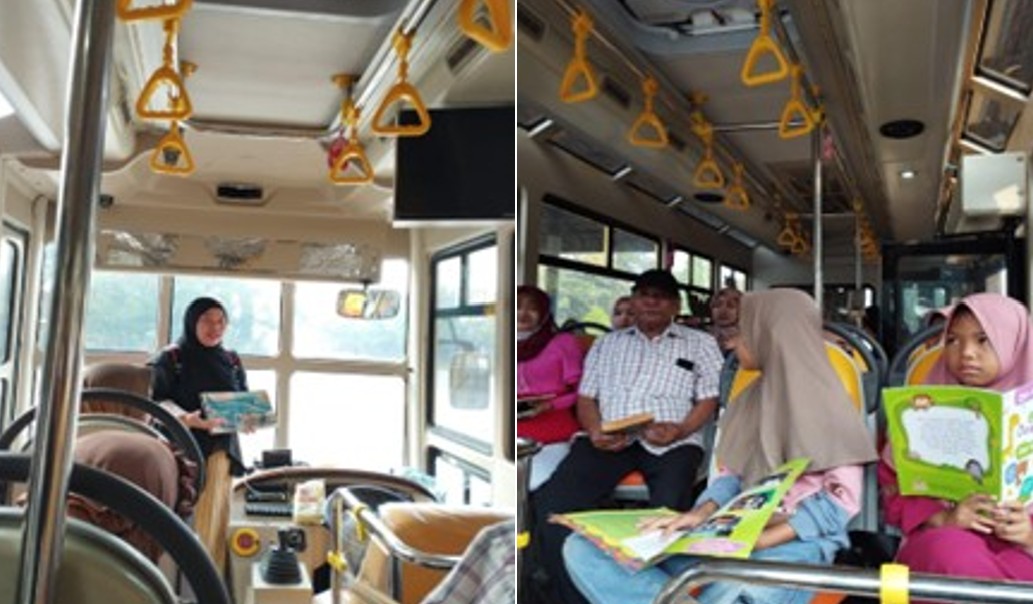Pelatihan penguatan literasi dasar penumpang transportasi umum (Bus Si Mas Ganteng) rute Bojonegoro – Tuban
DOI:
https://doi.org/10.53088/penamas.v5i3.2043Keywords:
Basic Literacy, Public Transportation, Si Mas Ganteng BusAbstract
Public transportation in Tuban Regency, known as Bus Si Mas Ganteng, officially operates on the Bojonegoro–Tuban route and has attracted strong enthusiasm from the community, particularly children and mothers. The bus service is free of charge and features clean facilities, air conditioning, a distinctive design, and a focus on passenger comfort and safety. These conditions provide a strategic opportunity to implement basic literacy training during travel. The purpose of this community engagement program is to foster passengers’ reading interest through interactive literacy approaches in public transportation. The methods employed include structured training, 30-minute reading practice sessions, and activities designed to promote reading with enjoyment. The results show that the literacy training successfully engaged 10 child passengers and three adult passengers. Participants demonstrated an understanding of the importance of literacy and expressed a commitment to applying it in daily life. Passengers were encouraged to read for at least 30 minutes, participate in discussions, and receive guidance from lecturers and students. In addition, the team contributed 20 books as a collection for Bus Si Mas Ganteng. This activity demonstrates that public transportation can serve as an educational space to foster a literacy culture and encourage communities to develop sustainable reading habits.
References
Ainiyah, N. (2017). Membangun penguatan budaya literasi media dan informasi dalam dunia pendidikan. Jurnal Pendidikan Islam Indonesia, 2(1), 65-77. http://doi.org/10.35316/jpii.v2i1.63
Azhaar, P. S., & Bataha, K. (2023). Peningkatan Literasi Siswa Sdn 3 Singotrunan Melalui Program 30 Menit Giat Membaca. Karya: Jurnal Pengabdian Kepada Masyarakat, 3(2), 288-292.
Damayantie, A. R. (2015). Literasi dari era ke era. Sasindo: Jurnal Pendidikan Bahasa dan Sastra Indonesia, 3(1), 1-10. https://doi.org/10.26877/sasindo.v3i1.2076
Firdaus, M. Z., & Sukiman, S. (2020). Menumbuhkan Budaya Baca Mahasiswa Melalui Program Literasi Sepuluh Menit Sebelum Perkuliahan. Educatio, 15(2), 104-114. https://doi.org/10.29408/edc.v15i2.2804
Fitri, A. T. (2025). Transformasi literasi digital menuju literasi global di era tanpa batas: Perspektif dunia remaja. IHSAN: Jurnal Pendidikan Islam, 3(2), 418-425. https://doi.org/10.61104/ihsan.v3i2.928
Gogahu, D. G. S., & Prasetyo, T. (2020). Pengembangan media pembelajaran berbasis e-bookstory untuk meningkatkan literasi membaca siswa Sekolah Dasar. Jurnal Basicedu, 4(4), 1004-1015. https://doi.org/10.31004/basicedu.v4i4.493
Hamzah, R. A. (2025). Bimbingan Teknis Satuan Pendidikan “Penguatan Literasi dan Numerasi” di Hotel Best Western Kota Makassar. Solidaritas: Jurnal Pengabdian, 5(1), 27-38.
JTV Bojonegoro. (2025). Minat Baca Tinggi, 19.000 Warga Bojonegoro Kunjungi Perpus Sepanjang 2024. https://www.jtvbojonegoro.com/2025/02/minat-baca-tinggi-19000-warga.html
Kamalasari, V. (2012). Latihan Membaca Cepat Sebagai Upaya Meningkatkan Kemampuan Membaca Cepat dan Pemahaman Bacaan. Basastra, 1(1), 53373. https://doi.org/10.24114/bss.v1i1.189
Maryatin, M., & Yuliani, T. (2019). Membudayakan Literasi pada Masyarakat di Kelurahan Gunung Bahagia Balikpapan Selatan. Jurnal Terapan Abdimas, 4(1), 57-62.
Meilinda, N., Malinda, F., & Aisyah, S. M. (2020). Literasi digital pada remaja digital (Sosialisasi pemanfaatan media sosial bagi pelajar Sekolah Menengah Atas). Jurnal Abdimas Mandiri, 4(1), 62-69. https://doi.org/10.36982/jam.v4i1.1047
Mumayizah, M., Hamidah, N., Thenaya, P. F., & Wijayanti, M. D. (2023). Penguatan Literasi dan Numerasi Menggunakan Adaptasi Teknologi dalam Pembelajaran di SD oleh Kampus Mengajar Angkatan 6. Social, Humanities, and Educational Studies (SHES): Conference Series, 6(3), 320-326. https://doi.org/10.20961/shes.v6i3.82366
Nurhayati, R. (2019). Membangun budaya literasi anak usia dini dalam keluarga. Nuansa Akademik: Jurnal Pembangunan Masyarakat, 4(1), 79-88. https://doi.org/10.47200/jnajpm.v4i1.918
Setiawan, F. M. S. F., Wijaya, K. A. S., & Lukman, J. P. (2025). Efektivitas Program Bus Sekolah Oleh Dinas Perhubungan Dalam Menunjang Transportasi Umum Di Kota Denpasar. Socio-political Communication and Policy Review, 2(3), 1-14. https://doi.org/10.61292/shkr.229
Suratmi, S., Ilhami, A., Azka, D. A., Defliyanto, D., Nopriyanti, N., & Nurhasan, N. (2025). Pelatihan penguatan literasi dan numerasi dalam pemulihan pembelajaran pada SMP di Kabupaten Ogan Ilir. Jurnal Pengabdian UNDIKMA, 6(1), 70-80. https://doi.org/10.33394/jpu.v6i1.13600
Syahirah, S. (2022). Upaya Edukasi Pentingnya Membaca Buku Sejak Usia Dini Di Desa Hamparan Perak Kecamatan Hamparan Perak. Maslahah: Jurnal Pengabdian Masyarakat, 3(3), 146-153. https://doi.org/10.56114/maslahah.v3i3.438
Ulfadilah, N., & Setiasih, O. (2024). Kegiatan jurnal pagi sebagai upaya mengembangkan kemampuan pra literasi anak usia dini. PAUDIA: Jurnal Penelitian Dalam Bidang Pendidikan Anak Usia Dini, 351-358. https://doi.org/10.26877/paudia.v13i2.1062
Wulanjani, A. N., & Anggraeni, C. W. (2019). Meningkatkan minat membaca melalui gerakan literasi membaca bagi siswa sekolah dasar. Proceeding of Biology Education, 3(1), 26-31. https://doi.org/10.21009/pbe.3-1.4
Yansyah, Y., Hamidah, J., & Ariani, L. (2021). Pengembangan Big Book Storytelling Dwibahasa untuk Meningkatkan Literasi Anak Usia Dini. Jurnal Obsesi : Jurnal Pendidikan Anak Usia Dini, 6(3), 1449–1460. https://doi.org/10.31004/obsesi.v6i3.1779
Zahra, N. (2023). Meningkatkan Inklusi dalam Indeks Literasi Digital Nasional: Dari Pengukuran hingga Pemberdayaan. Ringkasan Kebijakan No 19. CIPS: Center For Indonesian Policy Studies

Downloads
Published
How to Cite
Issue
Section
License
Copyright (c) 2025 Siti Nur Aisya Putri

This work is licensed under a Creative Commons Attribution-ShareAlike 4.0 International License.
Authors who publish with this journal agree to the following terms:
The author(s) retain copyright and grant the journal the right of first publication with the work simultaneously licensed under a CC BY-SA 4.0 license that allows others to remix, adapt, and build upon the work even for commercial purposes, as long as they credit the author(s) and license their new creations under the identical terms.
License details: https://creativecommons.org/licenses/by-sa/4.0/


